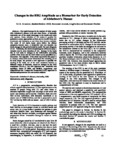Changes in the EEG amplitude as a biomarker for early detection of Alzheimer's disease.
| dc.contributor.author | Al-Nuaimi, Ali H. Husseen | |
| dc.contributor.author | Jammeh, Emmanuel | |
| dc.contributor.author | Lingfen Sun, | |
| dc.contributor.author | Ifeachor, Emmanuel | |
| dc.date.accessioned | 2019-05-13T05:57:38Z | |
| dc.date.available | 2019-05-13T05:57:38Z | |
| dc.date.issued | 2016-08 | |
| dc.identifier.issn | 2375-7477 | |
| dc.identifier.issn | 2694-0604 | |
| dc.identifier.uri | http://hdl.handle.net/10026.1/13829 | |
| dc.description | File replaced (incorrect version) on 01/08/2022 by KT (LDS). | |
| dc.description.abstract |
The rapid increase in the number of older people with Alzheimer's disease (AD) and other forms of dementia represents one of the major challenges to the health and social care systems. Early detection of AD makes it possible for patients to access appropriate services and to benefit from new treatments and therapies, as and when they become available. The onset of AD starts many years before the clinical symptoms become clear. A biomarker that can measure the brain changes in this period would be useful for early diagnosis of AD. Potentially, the electroencephalogram (EEG) can play a valuable role in early detection of AD. Damage in the brain due to AD leads to changes in the information processing activity of the brain and the EEG which can be quantified as a biomarker. The objective of the study reported in this paper is to develop robust EEG-based biomarkers for detecting AD in its early stages. We present a new approach to quantify the slowing of the EEG, one of the most consistent features at different stages of dementia, based on changes in the EEG amplitudes (ΔEEGA). The new approach has sensitivity and specificity values of 100% and 88.88%, respectively, and outperformed the Lempel-Ziv Complexity (LZC) approach in discriminating between AD and normal subjects. | |
| dc.format.extent | 993-996 | |
| dc.format.medium | ||
| dc.language.iso | en | |
| dc.subject | Alzheimer Disease | |
| dc.subject | Dementia | |
| dc.subject | Early Diagnosis | |
| dc.subject | Electroencephalography | |
| dc.subject | Humans | |
| dc.title | Changes in the EEG amplitude as a biomarker for early detection of Alzheimer's disease. | |
| dc.type | conference | |
| dc.type | Journal Article | |
| plymouth.author-url | https://www.ncbi.nlm.nih.gov/pubmed/28268491 | |
| plymouth.volume | 2016 | |
| plymouth.publication-status | Published | |
| plymouth.journal | Annu Int Conf IEEE Eng Med Biol Soc | |
| dc.identifier.doi | 10.1109/EMBC.2016.7590869 | |
| plymouth.organisational-group | /Plymouth | |
| plymouth.organisational-group | /Plymouth/Faculty of Science and Engineering | |
| plymouth.organisational-group | /Plymouth/Faculty of Science and Engineering/School of Engineering, Computing and Mathematics | |
| plymouth.organisational-group | /Plymouth/REF 2021 Researchers by UoA | |
| plymouth.organisational-group | /Plymouth/REF 2021 Researchers by UoA/UoA11 Computer Science and Informatics | |
| plymouth.organisational-group | /Plymouth/Users by role | |
| plymouth.organisational-group | /Plymouth/Users by role/Academics | |
| dc.publisher.place | United States | |
| dc.identifier.eissn | 2694-0604 | |
| dc.rights.embargoperiod | Not known | |
| rioxxterms.versionofrecord | 10.1109/EMBC.2016.7590869 | |
| rioxxterms.licenseref.uri | http://www.rioxx.net/licenses/all-rights-reserved | |
| rioxxterms.type | Conference Paper/Proceeding/Abstract |


